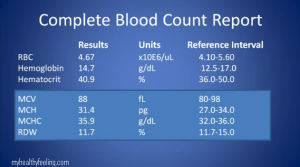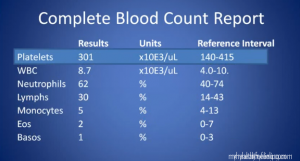How to interpret and understand blood test results? A complete blood count is a test panel that gives complete information about the kinds and numbers of cells found in the blood. Also referred to as blood panel, full blood exam or full blood count, this test is one of the most common laboratory tests requested by medical professionals to make a diagnosis. Complete blood count basically consists of the concentrations of the three major cells found in the blood – the red blood cells or erythrocytes, white blood cells or leukocytes, and the platelets or thrombocytes. Abnormal levels of any of the components may indicate a disease or condition.
How is the Complete Blood Count test performed?
For the test to be done, you have to submit your blood sample to a medical laboratory. The lab technician will draw a few milliliters of your blood by inserting a needle to a vein through your skin. The blood is collected in a vial which will then be analyzed in the laboratory
What are the parameters analyzed in a Complete Blood Count?
The following are the components of blood measured in a complete blood count. Note that laboratories may slightly differ in the standard ranges for each parameter. It is important to note what standard values they are using so that interpretation of the results would be more precise. In addition, included are the possible interpretations of the values obtained from the complete blood count.
• White blood cell (WBC) count
White blood cells fight the causes of infection in the body. If there is an increase in WBC count, this could be indicative of an infection.
Normal: 4,300 – 10,800 cells/cmm
High WBC:
Infections, damage to tissues, inflammation, injury, burns, tuberculosis, malnutrition and diseases like cancer can raise the WBC. Kidney failure, rheumatoid arthritis, lupus, corticosteroid use, thyroid and adrenal gland problems also cause high WBC.
Low WBC:
WBC is reduced when there are viral infections, aplastic anemia, AIDS, malaria, lupus or Cushing’s syndrome. Reactions to medication, chemotherapy, alcoholism and a large spleen also lower the WBC.
• White blood cell types (WBC differential)
There are different types of WBC and they are distinguished according to their shapes and sizes. Basophils, eosinophils, neutrophils, lymphocytes and monocytes are the cells in a differential count. The counts of each of these reflect the status of the immune system and can aid in determining the existence of diseases, toxic or allergic reactions and infections.
Normal:
Basophils: 0.5% – 1% relative value (25-100 absolute value)
Eosinophils: 1 – 4% relative value (50-400 absolute value)
Lymphocytes: 25 – 40% relative value (1700-3400 absolute value)
Monocytes: 2 – 8% relative value (200-600 absolute value)
Neutrophils (or segs): 50 – 70% relative value (3000-7000 absolute value)
Band neutrophils: 3 – 6%
• Red blood cell (RBC) count
The RBC count refers to the number of red blood cells in a given volume of blood. The red blood cells are transporters of oxygen from the lungs to the different parts of the body; while it also returns carbon dioxide from the body parts to the lungs to be expelled.
Normal:
Men: 4.7-6.1 million RBCs per mcL
Women: 4.2-5.4 million RBCs per mcL
Children: 4.0-5.5 million RBCs per mcL
Newborn: 4.8-7.1 million RBCs per mcL
High RBC:
This may be due to lack of fluid in the body. Dehydration, vomiting, use of diuretics are some conditions that make RBC seem high. High RBC could also be a result of lung, kidney, liver and heart diseases; smoking and drinking alcohol, among others.
Low RBC:
The main cause of low levels of RBC is anemia. Anemia could be from a variety of factors such as heavy menstrual bleeding, inflammatory bowel disease, stomach ulcers, lack of vitamin B12 or folic acid, reactions to medications and others.
• Hematrocit (HCT, packed cell volume, PCV)
This refers to the volume of RBC with respect to the volume of the whole blood. Together with Hemoglobin values, Hematrocit values could show the presence of anemia and polycythemia.
Normal:
Men: 42%-52%
Women: 37%-47%
Pregnant women: 1st trimester: 35%-46%
2nd trimester: 30%-42%
3rd trimester: 34%-44%
Postpartum: 30%-44%
Children: 32%-44%
Newborns: 44%-64%
• Hemoglobin (HgB)
This shows how much hemoglobin is present in the blood and reflects the capacity of the blood to carry oxygen. The red color of the blood is attributed to hemoglobin.
Normal:
Men: 14-18 g/dL or 8.7-11.2 mmol/L
Women: 12-16 g/dL or 7.4-9.9 mmol/L
Pregnant women: 1st trimester: 11.4-15.0 g/dL or 7.1-9.3 mmol/L
2nd trimester: 10.0-14.3 g/dL or 6.2-8.9 mmol/L
3rd trimester: 10.2-14.4 g/dL or 6.3-8.9 mmol/L
Postpartum: 10.4-18.0 g/dL or 6.4-9.3 mmol/L
Children: 9.5-15.5 g/dL
Newborn: 14-24 g/dL
• Red blood cell indices
The MCV, or mean corpuscular volume, is the size of the red blood cells; the MCH (mean corpuscular hemoglobin) is the quantity of hemoglobin present in a red blood cell; while the MCHC (mean corpuscular hemoglobin concentration) shows the proportion of hemoglobin in a red blood cell. These indices are vital in finding the cause of anemia.
Normal :
MCV: 82-98 fL
MCH: 26-34 pg
MCHC: 31-38 g/dL or 31%-38%
• Red cell distribution width (RDW)
This measures the red blood cell shape and size variability. The higher the variation, the higher the RDW is.
Normal: 11.5%-14.6%
• Platelet (thromobocyte) count
Platelets are the smallest cells of the blood and serve an important role in blood clotting. Platelet count in a complete blood count refers to the number of platelets in a given volume of blood.
Normal:
Children: 150,000-450,000 platelets per mm3 or 150-450 x 109/liter (SI units)
Adults: 150,000-400,000 platelets per mm3 or 150-400 x 109/liter (SI units)
High platelet:
This is usually a result of bleeding, bone marrow issues, iron deficiency and diseases such as cancer.
Low platelet:
Large spleen, pregnancy and idiopathic thrombocytopenic purpura may lead to low platelet count.


My. friend. took. a. blood. test. and. his. white. cells, were. up to
19. this. mean. he. has. lequmia, how. high. is. to. high
to. be. lequmia. thanks